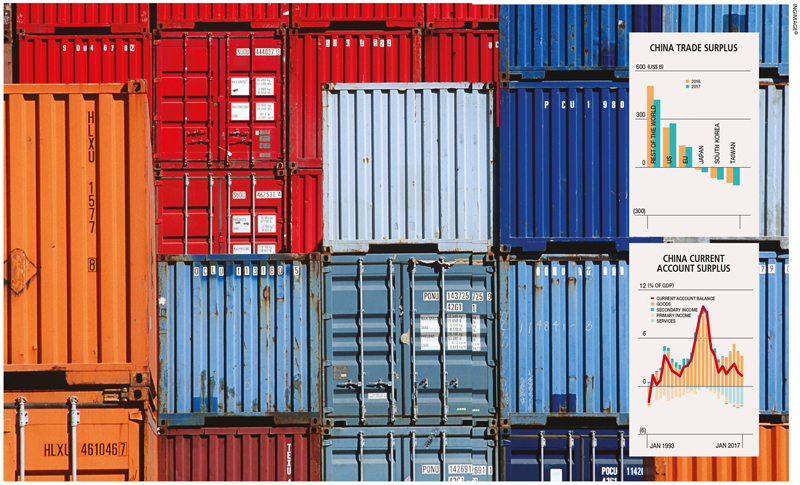GLOBAL TRADE
LOOMING THREAT TO WORLD TRADE
Samantha Amerasinghe evaluates the likelihood of tit for tat trade barriers in response to recent US tariffs
Markets are worried about the prospect of another global trade war. A full-blown trade waris unlikely but increased US protectionism is a major threat to international trade given America’s status as the world’s largest importer.
Recently, investor attention has focussed on the greater protectionist measures announced by the Trump administration and likely retaliation that may follow from major trading partners of the US.
Global growth remains strong (the OECD revised its forecast for world growth in 2018 to 3.9% from 3.7% last November) with improvements expected in almost every country except Russia. Tit for tat trade barriers in response to the Trump administration’s tariffs on steel and aluminium, and Section 301 trade remedies, threaten to undermine the strong global growth outlook.
However, there is no sign yet that the slide into a potential trade war is having an impact. In 2019, the world economy is expected to expand by 3.9 percent – a level similar to pre-crisis rates. Nevertheless, trade protectionism remains a key risk that would negatively impact confidence, investment and jobs.
The impact of US protectionism on the rest of the world is partly a function of how important the export sector is for a country’s GDP. While China has the largest trade surplus with the US and accounts for approximately 20 percent of all imports to the US, the impact of protectionism on its GDP is moderated somewhat by the low relative importance of exports in GDP.
That being said, US-China trade frictions are set to intensify.
China’s trade surplus with the US widened to US$ 276 billion in 2017 (10% more than 2016). Bilateral trade imbalances are likely to worsen further as the US introduces fiscal stimulus and China pursues deleveraging.
Politically, President Donald Trump appears to be ready to live up to his campaign promises to punish China for alleged unfair trade practices – especially after hopes of China pressuring North Korea into backing down on its nuclear programme were shattered and as US midterm elections draw near.
While the recently announced tariff on steel and aluminium would have an insignificant impact on China’s foreign trade, Section 301 trade remedies can be more harmful. China’s response to the trade frictions is likely to be measured and conciliatory, with a focus on trade in goods and services.
China accounts for very little of the steel or aluminium imported by the US. In 2017, China’s steel exports to the US amounted to approximately two billion dollars (about 3.6% of its total steel exports). China’s aluminium exports to the US amounted to 1.9 billion dollars (about 16% of its total aluminium exports).
Steel and aluminium exports to the US accounted for less than 0.2 percent of China’s total exports last year. The US’ top foreign sources for steel and aluminium imports combined are Canada (US$ 12 billion), the EU (US$ 7.3 billion), South Korea (US$ 2.9 billion) and Mexico.
The settlement of the 1994-95 Japan US motor trade dispute provides some clues on how things may evolve under the Section 301 investigation.
In October 1994, the Clinton administration initiated an investigation into Japan’s automobile market under Section 301 and threatened to impose a 100 percent tariff on imports of luxury cars from Japan in May 1995. By end June 1995, the US and Japan reached a settlement over access to the latter’s automobile market. The settlement averted the imposition of a punitive tariff.
Japan also withdrew its complaints with the WTO against the unilateral sanctions. The United States gained increased access to the Japanese market for sales of American cars and parts. So the US and China could reach a similar agreement aimed at curbing bilateral imbalances.
The focus has shifted to the Article 301 investigation into China’s unfair practices in technology transfer and intellectual property – the US fears that over time, China may erode its dominance in the hi-tech industry. This investigation is likely to result in remedies that affect a wide range of Chinese products.
On 22 March, Trump announced that he would be imposing a 25 percent tariff on targeted Chinese imports worth 60 billion dollars as a result of the Section 301 investigation (but only after a 60 day consultation period). The tariffs are targeted at the 10 sectors China has prioritised in its Made in China 2025 industrial policy. While the tariffs are likely to be chiefly targeted at hi-tech industries including IT, consumer electronics and telcos, they could be much broader.
Consequently, trade frictions may intensify and raise fears of a widespread trade war. But this could be viewed more as a tactic of the Trump administration to win the largest possible concessions.
While China has stepped up its rhetoric, it is likely to strike a conciliatory tone and offer a fairly muted response. Bilateral negotiations will continue. China would not want to move to an economic confrontation that would destabilise its longer term plans of greater liberalisation and trade openness.
Therefore, a full-blown trade war remains a low risk at this juncture.







I don’t agree that President Trump is ready to live up to his campaign promise to punish China for what he has said are unfair trade practices because he now sounds like he wants them to trade with the USA. This is because he knows very well that China is now a big player in international trade and he does not want to isolate America. Yes, the US midterm elections are coming close and he will also have to think about them.
Why does the international community ask President Trump to think beyond his country? Because we live in a connected world and protectionism will not work. Everyone will suffer if there is a trade war. The poorest will suffer the most. That’s not good.